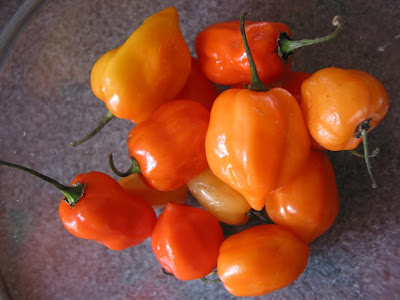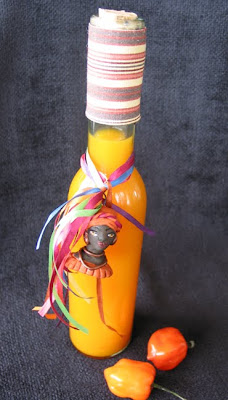
The other day I overheard a woman on the bus. She was telling her friend that the highlight of her kid's week was going out to eat hamburgers on Fridays. However, instead of hamburgers, the lady's husband took the kids out to eat tacos, so they were very upset. As someone that works in a predominately Latino neighborhood, a Mexican, and a food blogger, it made me think of the reasons for the disproportionate rates of obesity of Latinos in the US.
McMuertos turns 10 years old! The image above is from an artistic collaboration I was a part of, several years ago. McMuertos was an installation for a Dia de los Muertos show at the
Yerba Buena Center for the Arts, in 1998. It also appeared at the Oakland Museum in 1999, and the Mexican Museum in 2000. The installation was a parody dealing with cultural appropriation, predatory marketing and deceptive advertising. Much like his cousin "Joe Camel", the character of Ronnie Calaca (masterfully played by Robert Karimi, below) sold his brand using slick and unscrupulous messages that misinformed the public, especially kids.
 McMuertos Poster by John Leanos, circa 1999
McMuertos Poster by John Leanos, circa 1999On 2004, the movie "Super Size Me" dealt with some of those same issues, along with an experiment on portion control and health effects. Fast food portions had gotten out of control, in some cases five times bigger than portions in the 1950's, when restaurants began to mass produce hamburgers and fries. One of the biggest culprits of obesity in children could be HFCS 55 (High Fructose Corn Syrup), used to sweeten soft drinks. Since 1999, soft drink sizes got so big that they could no longer fit inside cup holders. HFCS is also found in cookies, bread, salad dressing, BBQ sauce, ketchup and many other condiments. But HFCS is not only found in fast food restaurants. McMuerto's message is still resonant today, as corporations try to sell us the "goodness" of HFCS and genetically modified food.
Changing, evolving cornCorn could be one of the most modified crops in the world. Originally corn was developed by cultivating a grass called "teosintle", more than 7000 years ago in what is currently Mexico. Corn became the staple food for the Aztecs, Mayas and many other North American indigenous groups. Teosintle (or Teozintle) literally means "food of the gods". The Mayas considered corn so sacred that they even deformed the heads of their babies using tablets, so they would appear elongated like an ear of corn.
 Yum Kaax, Mayan Corn God
Yum Kaax, Mayan Corn GodThe world has less fertile land since the time of the Maya. There is also the need to feed more people, and that has served as a motivation to create "stronger" crops that have more productive plants. The development of GMOs (Genetically Modified Organism) by corporations like
Monsanto are said to address those issues. But what is the cost? Today we are not only loosing a connection to nature, but we may also be at risk of loosing heirloom varieties of grain, maybe forever. GMO seed is copyrighted, so corporations can make money by selling it to farmers. "Terminator" seeds are sterile after planting, therefore ensuring farmer's dependency on suppliers. McMuerto's parodied corporate control, profit and greed. Those motivations need to be taken into consideration as well, when dealing with GMOs.
 Mayas Growing Corn
Mayas Growing CornThe image of a farmer in overalls, growing corn by hand, and tending to it with the help of a scarecrow is very much gone. The US is growing way too much corn at tax payer's expense, due to government subsidies. It is a "super crop" that is not only fed to cattle, but to other animals like farmed salmon. These animals have no natural way of processing GMO corn. In order to keep animals "healthy" (so they can grow larger faster) they are pumped full of antibiotics.
We still don't know the long term effects of eating and producing GMOs, eating them, and even the effects of eating animals that have been feed GMOs. So far the news are not good. According to the Huffington Post, Monsanto's corn has been linked to
organ failure in animals HFCS has been also linked to high triglycerides and diabetes. Diabetes Health has an article about
the dangers of HFCS. The Washington post has an article about how HFCS is also
not so sweet for the planet either. It could be a deadly triple whammy.
Mutant corn, harmless?
On a curious note, Monsanto is also a sponsor of many attractions at Disneyland and Walt Disney World. It seems like corporations are going after the youngest consumers, and their parents. For example,
The Sweet Surprise is a PR marketing wonderland that praises the benefits of high fructose corn syrup. The creepy parts is that, as opposed to McMuerto's, it is not a spoof. It is full of images of happy families on bikes, smiling children, and expert testimony. It even has downloadable and printable fliers about "kids and sweets", assuring parents that feeding HFCS to kids is not only OK, it could also be nutritious:
"By making healthy foods taste even more delicious, high fructose corn syrup may help ensure that picky young eaters get the nutrition they need". It could may be translated as - get them hooked up, early on.
Here is another quote, from Kris Clark, Ph.D, R.D., F.A.C.S.M., an assistant professor and Director of Sports Nutrition at Penn University:
"It's a reality that kids are going to have some sugar in their diets...." "Just be sure the majority of the added sugars they consume are from nutrient-rich food or beverage, and practice moderation with concentrated sweets like candy and desserts". Yet, there is no mention of HFCS as being a chemical manufactured in a lab, not present in nature, and one of the worse concentrated sugars. It is not a secret that all sugars should be consumed with moderation, the problem is that GMO corn and the many products manufactured with it are abundant. HFCS is not "moderate" by any means, as used on baked goods, snacks, chips, cookies, dressings, juices, sodas and many other products.
Corn is ours
Going back to the lady on the bus. She was large, and I wondered about the chances of her kids being overweight as well. I didn't know her, yet in my mind I was looking for reasons for her obesity. Maybe she is a newly arrived immigrant, feeding her children burgers may be her way to become "American" and fit in. Maybe it is more convenient to feed her kids fast food, after a long work week. Maybe she really thinks she is giving the the kids a little "reward" on Friday nights. Or maybe it is cheaper to get several items at the "dollar menu". I wonder how many people eat fast food out of convenience, or necessity. As opposed to businesses that have been hurt by the economy, McDonald's actually posted a growth of 2.5%
What about personal responsibility? There's been horrible hate crimes against Latinos, and virulent attacks by the likes of Lou Dobbs on the media recently. Harsh comments on newsgroups dealing with this topic also abound: "Nobody is putting a gun to their heads (forcing them to make poor food choices)", "Mexicans are fat because they are lazy", "Mexican food is so bad for you...(because) the ingredients are greasy (cheap, or poor quality, etc)". I think we can we find balance between personal responsibility and economic disparity. One of the saddest parts of the movie "Food inc" showed an obese Latino family buying fresh groceries. A little girl asks for pears, yet her older sister declines because they are too expensive.

So, what are the answers? The education of the public is key, as well as creating awareness in regards to food justice. Favianna Rodriquez, an amazing socially aware artist is doing a wonderful job educating the community about the importance of
rejecting GMOs and agribusiness. On her website she talks about larger issues dealing with the dangerous ripples sent out by US policies regarding industrialized agriculture, and how they affect local food growers and those beyond our borders. She recently donated a poster of the image above to a charity auction I recently organized.
Un millon de gracias, Favianna! Nutritional WastelandsMexican food doesn't have to be unhealthy, that is one of the reasons for this blog. As Latinos we still need to explore genetics, education, culture and economics, and how they play a big part on health and eating habits. So, what stops someone from getting locally grown veggies, organic tortillas and making fresh salsa? Some kids are growing up in nutritional wastelands. Super markets in poor neighborhoods carry less organic selections. Corner stores and liquor stores carry heavy processed food, often times folks have to do a lot of their shopping there, because those are the only stores available. There are fast food chains on each side of the main streets that delineate the neighborhood where I work. Like liquor stores, they are disproportionally located in neighborhoods where poor people live. And of course, fast food chains also have hordes of marketers that make humble veggie tacos seem unappealing.
So what can we do? We can support local organic farmers. As consumers, we can demand an end to GMO production. We can stop buying corn heavy foods that only feed corporations and conglomerates. Most of all, we can educate our communities. That is the cruelest of ironies for Latinos everywhere: What once was a sacred crop to our ancestors, could be killing us now.
Links:- The illustration of the Mayans planting corn is by Alberto Beltran, for the book "Los Mayas" by Victor W. Von Hagen.
- You can help farmers in Mexico fight big agro businesses. Visit the environmental group Sierra de Guadalupe. They promote bio diversity, and educate farmers in central Mexico about the importance of planting local species organically. There is a donate button at the end of the page.
- The image God E (Yum Kaax, the Corn God - "Lord of The Harvest Fields") is from Copan. Photo by the American Museum of Natural History, in New York.
- You can go to the Organic Consumers Association and join the "Millions Against Monsanto" by signing their on-line petition
- Support the work of John Leanos and Favianna Rodriguez















